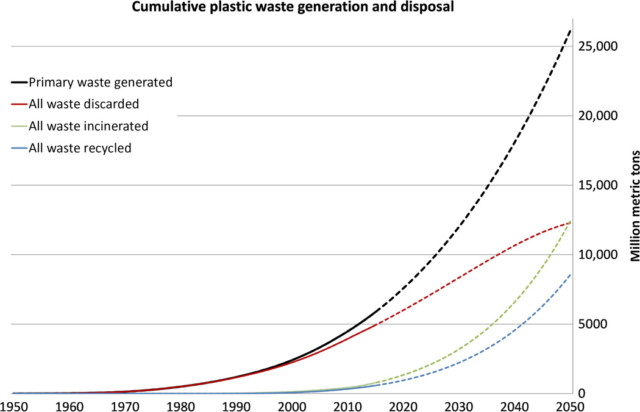Plastics are everywhere, and are used everyday. So how much plastic waste is being generated by all of the plastics in use?
As of 2015, around 6,300 metric tons of plastic waste have been created, according to a report released in the journal Science Advances.
When it comes to plastic, the numbers are staggering:
Over nine billion tons of plastic have been produced since 1950.

Cumulative plastic waste generation and disposal (in million metric tons). Graphic: journal Science Advances
Of the 6,300 tons of plastic waste that has been created since 2015, only around nine percent has been recycled—12 percent was incinerated and 79 percent was put in landfills or in nature.
According to the report, if current trends continue, around 12,000 tons of plastic will be in nature or in landfills by 2050.
Plastic waste has been found in all major oceans, according to the report.
The concern surrounding plastic waste is its problematic disposal. It can be recycled, which the report says “delays, rather than avoids final disposal.” Plastics can also be burned, which has potentially detrimental impacts to the environment. Aside from incineration or recycling, dumping plastic waste in landfills or in nature are the only remaining disposal options for plastic waste.
According to the report, between the years 1950 and 2015,12 percent of plastics have been burned, nine percent have been recycled, 10 percent have been recycled more than once (delaying the disposal), and 60 percent of the plastics produced are sitting in either landfills or in nature.
The issue with disposal of plastics in either landfills or in nature is that mass-produced plastics are not designed to biodegrade “in any meaningful way,” according to the report.
Since 1980, nonfiber plastics have been the focus of recycling efforts. The study found that according to available data, the highest recycling rates globally in 2014, were 30 percent in Europe and 25 percent in China. Recycling rates have stayed steady at nine percent in the United States, according to the study.
 CGTN America
CGTN America
 FILE – In this March 12, 2015 file photo, plastic trash is compacted into bales ready for further processing at the waste processing dump on the outskirts of Minsk, Belarus. A new massive study finds that production of plastic and the hard-to-breakdown synthetic waste is soaring in huge numbers. The study says since 1950, industry has made more than 9 billion tons of plastics. That’s enough to cover the entire country of Argentina ankle deep in the stuff. (AP Photo/Sergei Grits)
FILE – In this March 12, 2015 file photo, plastic trash is compacted into bales ready for further processing at the waste processing dump on the outskirts of Minsk, Belarus. A new massive study finds that production of plastic and the hard-to-breakdown synthetic waste is soaring in huge numbers. The study says since 1950, industry has made more than 9 billion tons of plastics. That’s enough to cover the entire country of Argentina ankle deep in the stuff. (AP Photo/Sergei Grits)
